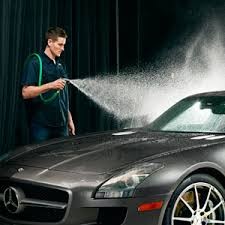Car Care - Use Deionised Water For the Final Rinse
One of the worst things to contend with when you are washing your car, especially on hot Summer days is water spots. No matter how hard you try it is sometimes almost impossible to stop water spots from appearing as your car dries. If this is a problem you are suffering from every time you wash your car then you will be pleased to know that the cause has been identified. You are using the wrong sort of water!
Now before you go off and say that you are fighting a lost cause because there is no way to change your water, there is a solution. You need to change to de-ionised water for the final rinse of your car.
What is De-ionisation?
Ions are simply impurities that exist in any normal water supply and come in the form of dissolved minerals such as calcium and sodium, When the water evaporates the minerals that were once dissolved in the water are left behind to leave unsightly spots on your paintwork. The normal course of action is to dry your car with a soft cloth or paper towel so that the water doesn't have time to evaporate and leave behind the spots. This is sometimes impractical though, especially on a hot day when the sun will dry parts of your car before you get a chance to get to them.
The de-ionisation process forces the dissolved ions out of the water through ion exchange. This involves exchanging negatively charged ions, called cations for hydrogen and positively charged ions, called anions for hydroxyl. This is done by passing the water through a filter containing resin beads that have a greater affinity for other ions.
When to use it
Normal application is to wash your car with normal water and thoroughly rinse with normal water too to make sure all the soap has been washed away. Then immediately rinse with deionised water. Due to the fact that the filter has a finite life and will only be able to exchange ions for a certain volume of water, it makes sense to only use the deionised water for the final rinse as otherwise you will end up changing filters more regularly than you otherwise need to. However, some people have reported getting a better lather from deionised water and so also use it for washing as well. It's up to you.
One good tip is to make sure that you concentrate particularly on areas where water tends to accumulate and therefore drip for a period of time after rinsing, such as bumpers and door mirrors.
Another tip is to perhaps avoid washing the car on a high pollen count day as for some reason pollen gets attracted to deionised water.
Once you have thoroughly rinsed the car with deionised water simply leave it to dry. You will notice not only that there are no water spots but also you car has an immediate shine to it as well. If you can't wait that long, I have heard of people using leaf blowers to dry their cars. Be careful with this though as the last thing you need to be doing to your paintwork is blowing dust and debris onto it which may cause scratches.
One final thing to note. During the final rinse you should notice that the deionised water beads very easily and runs off the surface of the paintwork almost like little ball of mercury. If you see this then you know the filter is working. As the resin beads inside the filter start to approach saturation the beading will start to diminish. That's when you know to buy a new filter.
You may think that the process sounds too complicated to be practical for the every day user, however, manufacturers such a are starting to release products that simply fix inline with your garden hose to give you an instant supply of deionised water.
Article Source: http://EzineArticles.com/3994844


Comments